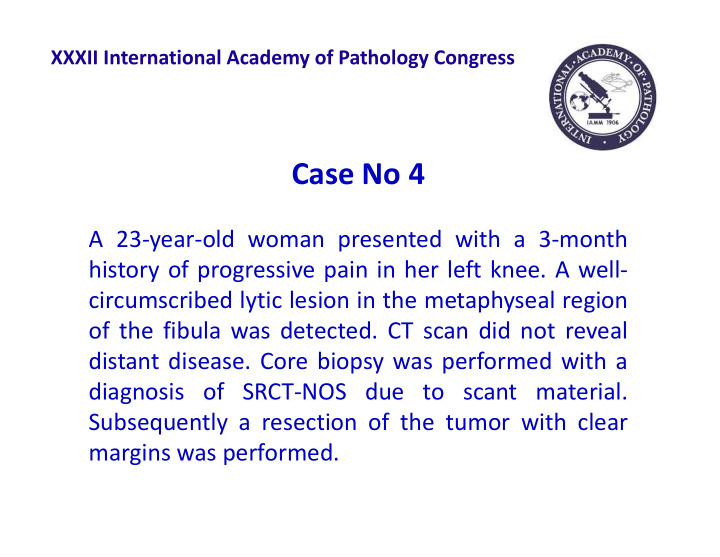



XXXII International Academy of Pathology Congress Case No 4 A 23‐year‐old woman presented with a 3‐month history of progressive pain in her left knee. A well‐ circumscribed lytic lesion in the metaphyseal region of the fibula was detected. CT scan did not reveal distant disease. Core biopsy was performed with a diagnosis of SRCT‐NOS due to scant material. Subsequently a resection of the tumor with clear margins was performed.
PAS
CD99 CD99 NKX2.2 ETV4
Immunohistochemical negative results • EMA, CK (AE1/AE3), CK18, CK5 • S100, p63, GFAP, CD10 • Melan‐A, HMB‐45, MITF1, SOX10, SOX9 • FLI‐1, CD34,ERG, CD31 • SMA, desmin, myogenin • Chromogranin, Synaptophysin, CD56, TTF‐1 • WT1, BCOR, CCNB3
EWSR1 EWSR1 GENE AMPLIFICATION OF THE 5 ´
EWSR1/NFATC2
Molecular Biology negative results • EWSR1/Fli1, EWSR1/ERG, EWSR1/ETV4, EWSR1/FEV • EWSR1/ATF1, EWSR1/CREB1 • EWSR1/NR4A3 • EWSR1/PBX1, EWSR1/ZNF444, EWSR1/POU5F1
EWSR1/NFATC2 sarcoma: Molecular Biology (nuclear factor of activated T‐cells, cytoplasmic, calcineurin‐dependent 2 also known as NFAT1 or NFATp ), Charville GL et al, Modern Pathol, 2018
EWSR1/NFATC2 sarcomas • Bone (8 cases) or soft tissue sarcoma (2 cases) • Long bones of young men in the second/third decades • Resemble a myoepithelial tumor, but immunophenotype does not fit within this category. • The clinical course is more indolent than that of Ewing sarcoma (ES) • Chemoresistant to the ES regimen. This lack of treatment response suggests a biological difference between EWSR1‐ NFATC2 tumors and Ewing sarcoma. Szuhai et al, Clin Cancer Res 2009. Cohen JN et al, Human Pathol, 2018 Charville GL et al, Modern Pathol, 2018 Baldauf MC, Modern Pathol, 2018
Srct tumor in young patients (bone or soft tissue) What are the most probable diagnoses? ‐Ewing sarcoma with Conventional EWSR1 gene fusion ‐Ewing with EWSR1/ETV4 and EWSR1/NFATC2 gene fusion ‐BCOR sarcomas ‐CIC‐DUX4 sarcomas ‐Myoepithelioma ‐Myxoid chondrosarcoma ‐Clear cell sarcoma. ‐Other undifferentiated srct ( NOS)
EWSR1/NFATC2 sarcomas Diagnostic pitfalls • Bone or soft tissue tumor • Myoepithelioma‐like pattern • EWSR1 translocation and EWSR1 amplification • Lack of BCOR, NR4A3 and CIC rearrangement • Frequent lack of myoepithelial markers • Poor response to conventional Ewing treatment.
TAF15‐NR4A3 Desmoplastic TCF12‐NR4A3 POU5F1; 6p21 Myoepithelial small round TFG‐NR4A3 PBX1 ; 1q23 carcinoma cell tumor ZNF444 ; 19q13 Myxoid NR4A3(TEC) chondrosarcoma 9q22 myxoid CHOP/DDIT3 WT1 11p13 liposarcoma 12q13 Angiomatoid fibrous ESFT histiocytoma ETS family EWSR1 EWSR1/CREB1 FLI‐1; 11q24 ESFT‐LIKE 22q12 FUS/ATF1 ERG; 21q22 FEV; 2q35 ATF1; 12q13 Classic clear cell ETV1; 7p22 CREB3L1; 2q321 sarcoma AML FUS/TLS ETV4; 17q12 (EWSR1/ATF1) ( FUS/ERG ) NFATC2; 20q13 ( EWSR1/CREB1 ) 16p11 SP3; 2q31 ESFT Clear cell PATZ1; 1q36.1 sarcoma salivary SMARCA5; 4q31 Pulmonary FUS/ERG gland CREB3L2; 7q33 ZSG; 22q12 myxoid sarcoma FUS/FEV ( EWSR1/ATF1 ) ( EWSR1/CREB1 ) CREB3L1; 11p11 Clear Cell Sarcoma–like Tumor of GIT Low‐grade fibromyxoid (EWSR1/ATF1) sarcoma and subset of ( EWSR1/CREB1 ) sclerosing epitheliod fibrosarcoma
SUMMARY OF FUSIONS IN CLASSICAL EWING SARCOMA AND EWING‐LIKE TUMORS Renzi et al. J Cell Physiol.2018.1‐9
EWSR1/NFATC2 sarcoma • Should it be excluded from the category of Ewing‐like sarcomas and similar tumors ?
XXXII International Academy of Pathology Congress Ewing‐like sarcoma with myoepithelioma‐like pattern and EWSR1/NFATC2 gene fusion Antonio Llombart‐Bosch 1 , Isidro Machado 2 , Akihiko Yoshida 3 ,Antonina Parafioriti 4 1‐Pathology Department, University of Valencia, Spain 2‐Pathology Department, Instituto Valenciano de Oncología, Valencia, Spain. 3‐Pathology Department, National Cancer Center, Tokyo , Japan. 4‐Pathology Department, Centro Specialistico Ortopedico Traumatologico Gaetano Pini, , Milan, Italy
VALENCIA: CITY OF ARTS AND SCIENCE FOTO DE VALENCIA THANKS FOR YOUR ATTENTION
Recommend
More recommend